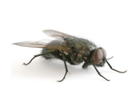
It's not the fruit fly and it's not the horse fly, but the most common fly around farms and homes might just be the most pestering one out there. House flies are not only a nuisance to people, an annoyance for pets and farm animals and a headache for anyone working outside, they can also become a very big public health concern.
Surprisingly, most adult house flies only live for about 15 to 25 days on average, according to the University of Florida IFAS. Some house flies even live for as long as two months. Winged, adult house flies are typically gray in color with several yellow markings. All flies have a thorax marked with broad dark stripes although the females are generally bigger than the males. They are found all throughout the U.S. and Canada and although they tend to remain 1 to 2 miles near their birthplace, research has found that some house flies have migrated up to 20 miles to find food.
According to the National Pest Management Association, house flies can only consume liquid food. However, they have the power to change solid foods into a liquid for consumption. Oddly, house flies eat and taste with their feet, which are 10 million times more sensitive than the human tongue to sugar. The University of Nebraska-Lincoln reported that much of what they feed on is liquid waste found in garbage, animal waste and spoiled fruits and vegetables. When eating, house flies also defecate on their food thus, making them highly threatening sources of transmitting disease. All of these feeding habits make house flies extremely likely to transmit disease.
Preventing house flies in your home is the best way to ensure sanitation. PennState College of Agriculture Sciences reported four basic principles of pest management when it comes to keeping out the house fly. These methods include - sanitation, exclusion, non-chemical measures and chemical methods. First and foremost, house flies cannot breed in large numbers when their sources of food are limited. Keep all trash, garbage and recycling bins covered. Do not let waste, weed piles or manure pile up. Secondly, for exclusion measures, ensure that all screens and doors are tightly fitted without any holes. Non-chemical measures include sticky fly traps, ultraviolet light traps, baited fly traps and good old fashioned fly swatters. If you are still have pest problems, call your local pest management professional for chemical measures.